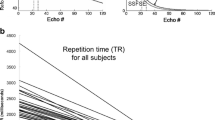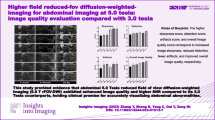Abstract
Background
Radial k-space sampling techniques have been shown to reduce motion artifacts in adult abdominal MRI.
Objective
To compare a T2-weighted radial k-space sampling MRI pulse sequence (BLADE) with standard respiratory-triggered T2-weighted turbo spin echo (TSE) in pediatric abdominal imaging.
Materials and methods
Axial BLADE and respiratory-triggered turbo spin echo sequences were performed without fat suppression in 32 abdominal MR examinations in children. We retrospectively assessed overall image quality, the presence of respiratory, peristaltic and radial artifact, and lesion conspicuity. We evaluated signal uniformity of each sequence.
Results
BLADE showed improved overall image quality (3.35 ± 0.85 vs. 2.59 ± 0.59, P < 0.001), reduced respiratory motion artifact (0.51 ± 0.56 vs. 1.89 ± 0.68, P < 0.001), and improved lesion conspicuity (3.54 ± 0.88 vs. 2.92 ± 0.77, P = 0.006) compared to respiratory triggering turbo spin-echo (TSE) sequences. The bowel motion artifact scores were similar for both sequences (1.65 ± 0.77 vs. 1.79 ± 0.74, P = 0.691). BLADE introduced a radial artifact that was not observed on the respiratory triggering-TSE images (1.10 ± 0.85 vs. 0, P < 0.001). BLADE was associated with diminished signal variation compared with respiratory triggering-TSE in the liver, spleen and air (P < 0.001).
Conclusion
The radial k-space sampling technique improved the quality and reduced respiratory motion artifacts in young children compared with conventional respiratory-triggered turbo spin-echo sequences.




Similar content being viewed by others
References
Chavhan GB, Babyn PS, Vasanawala SS (2013) Abdominal MR imaging in children: motion compensation, sequence optimization, and protocol organization. Radiographics 33:703–719
Pipe JG (1999) Periodically rotated overlapping parallel lines with enhanced reconstruction (PROPELLER) MRI: application to motion correction. In: 7th scientific meeting of the ISMRM, Philadelphia, pp 22–28
Dietrich TJ, Ulbrich EJ, Zanetti M et al (2011) PROPELLER technique to improve image quality of MRI of the shoulder. AJR Am J Roentgenol 197:1093–1100
Pipe JG (1999) Motion correction with PROPELLER MRI: application to head motion and free-breathing cardiac imaging. Magn Reson Med 42:963–969
Forbes KP, Pipe JG, Bird CR et al (2001) PROPELLER MRI: clinical testing of a novel technique for quantification and compensation of head motion. J Magn Reson Imaging 14:215–222
Pipe JG, Zwart N (2006) Turboprop: improved PROPELLER imaging. Magn Reson Med 55:380–385
Tamhane AA, Arfanakis K (2009) Motion correction in periodically‐rotated overlapping parallel lines with enhanced reconstruction (PROPELLER) and turboprop MRI. Magn Reson Med 62:174–182
Von Kalle T, Blank B, Fabig-Moritz C et al (2010) Diagnostic relevant reduction of motion artifacts in the posterior fossa by syngo BLADE imaging. MAGNETOM Flash 43:6–11
Hirokawa Y, Isoda H, Maetani YS et al (2009) Hepatic lesions: improved image quality and detection with the periodically rotated overlapping parallel lines with enhanced reconstruction technique—evaluation of SPIO-enhanced T2-weighted MR images. Radiology 251:388–397
Lane BF, Vandermeer FQ, Oz RC et al (2011) Comparison of sagittal T2-weighted BLADE and fast spin-echo MRI of the female pelvis for motion artifact and lesion detection. AJR Am J Roentgenol 197:307–313
Hirokawa Y, Isoda H, Maetani YS et al (2008) MRI artifact reduction and quality improvement in the upper abdomen with PROPELLER and prospective acquisition correction (PACE) technique. AJR Am J Roentgenol 191:1154–1158
Forbes KP, Pipe JG, Karis JP et al (2003) Brain imaging in the unsedated pediatric patient: comparison of periodically rotated overlapping parallel lines with enhanced reconstruction and single-shot fast spin-echo sequences. AJNR Am J Neuroradiol 24:794–798
Deng J, Miller FH, Salem R et al (2006) Multishot diffusion-weighted PROPELLER magnetic resonance imaging of the abdomen. Invest Radiol 41:769–775
Hirokawa Y, Isoda H, Maetani YS et al (2008) Evaluation of motion correction effect and image quality with the periodically rotated overlapping parallel lines with enhanced reconstruction (PROPELLER) (BLADE) and parallel imaging acquisition technique in the upper abdomen. J Magn Reson Imaging 28:957–962
Michaely HJ, Kramer H, Weckbach S et al (2008) Renal T2‐weighted turbo‐spin‐echo imaging with BLADE at 3.0 tesla: initial experience. J Magn Reson Imaging 27:148–153
Deng J, Omary RA, Larson AC (2008) Multishot diffusion‐weighted SPLICE PROPELLER MRI of the abdomen. Magn Reson Med 59:947–953
Alkan Ö, Kizilkilic O, Yildirim T et al (2009) Comparison of contrast-enhanced T1-weighted FLAIR with BLADE, and spin-echo T1-weighted sequences in intracranial MRI. Diagn Interv Radiol 15:75–80
Fries P, Runge VM, Kirchin MA et al (2009) Diffusion-weighted imaging in patients with acute brain ischemia at 3 T: current possibilities and future perspectives comparing conventional echoplanar diffusion-weighted imaging and fast spin echo diffusion-weighted imaging sequences using BLADE (PROPELLER). Invest Radiol 44:351–359
Vertinsky A, Rubesova E, Krasnokutsky M et al (2008) PROPELLER FSE T2-weighted imaging in pediatric brain imaging: can we replace standard FSE T2-weighted imaging? Proc Intl Soc Magn Reson Med 2008:2056
Alibek S, Adamietz B, Cavallaro A et al (2008) Contrast-enhanced T1-weighted fluid-attenuated inversion-recovery BLADE magnetic resonance imaging of the brain: an alternative to spin-echo technique for detection of brain lesions in the unsedated pediatric patient? Acad Radiol 15:986–995
Forbes KP, Pipe JG, Karis JP et al (2002) Improved image quality and detection of acute cerebral infarction with PROPELLER diffusion-weighted MR imaging. Radiology 225:551–555
Narayanan D, Madsen KS, Kalinyak JE et al (2011) Interpretation of positron emission mammography and MRI by experienced breast imaging radiologists: performance and observer reproducibility. AJR Am J Roentgenol 196:971–981
Landis JR, Koch GG (1977) The measurement of observer agreement for categorical data. Biometrics 33:159–174
Yang RK, Roth CG, Ward RJ et al (2010) Optimizing abdominal MR imaging: approaches to common problems. Radiographics 30:185–199
Darge K, Anupindi SA, Jaramillo D (2011) MR imaging of the abdomen and pelvis in infants, children, and adolescents. Radiology 261:12–29
Bayramoglu S, Kilickesmez Ö, Cimilli T et al (2010) T2-weighted MRI of the upper abdomen: comparison of four fat-suppressed T2-weighted sequences including PROPELLER (BLADE) technique. Acad Radiol 17:368–374
Haneder S, Dinter D, Gutfleisch A et al (2011) Image quality of T2W-TSE of the abdomen and pelvis with Cartesian or BLADE-type k-space sampling: a retrospective interindividual comparison study. Eur J Radiol 79:177–182
Rafat Zand K, Reinhold C, Haider MA et al (2007) Artifacts and pitfalls in MR imaging of the pelvis. J Magn Reson Imaging 26:480–497
Li BK, D’Arcy M, Weber E et al (2008) A new method in accelerating PROPELLER MRI. Conf Prox IEEE Eng Med Biol Soc 2008:1655–1658
Acknowledgments
We thank Allison Alley for language consultation and editing.
Conflicts of interest
None
Author information
Authors and Affiliations
Corresponding author
Rights and permissions
About this article
Cite this article
Lee, J.H., Choi, Y.H., Cheon, J.E. et al. Improved abdominal MRI in non-breath-holding children using a radial k-space sampling technique. Pediatr Radiol 45, 840–846 (2015). https://doi.org/10.1007/s00247-014-3244-1
Received:
Revised:
Accepted:
Published:
Issue Date:
DOI: https://doi.org/10.1007/s00247-014-3244-1




